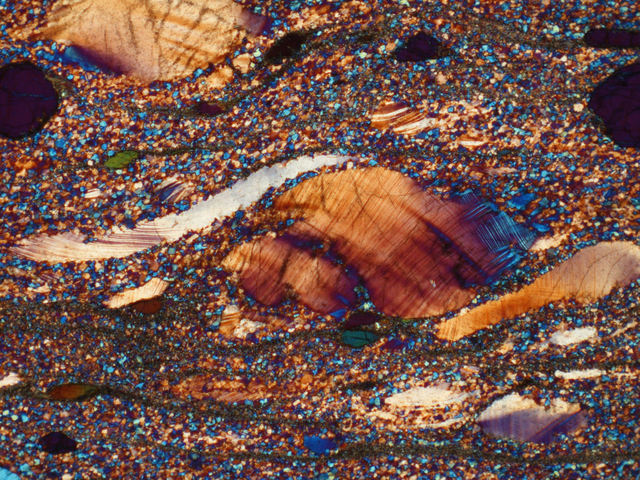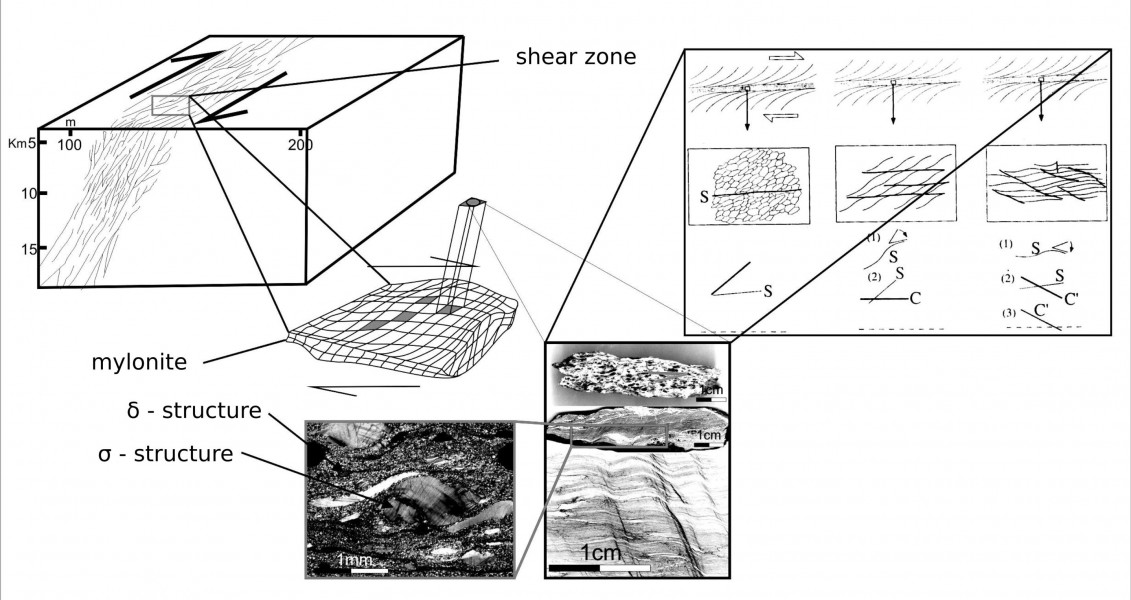Geológia‚ ktorá nás chráni...

GEOLOGY |
Vitajte na stránke ekogeo.wbl.sk v sekcii GEOLOGY
1. CETeG 2011 Michal Hoffman:
SENSE of MOVEMENTS ANALYSIS shear zones FROM MICRO-STRUCTURES IN GRANITIC MYLONITES (Bratislava massif)
Michal Hoffman
Department of Geology and Palaeontology, Faculty of Natural Sciences, Comenius University, Mlynska dolina pav. G, SK 84215, Bratislava, The Slovak Republic, (hoffman.geology@gmail.com).
One of the most characteristic properties of mylonites (Lapworth, 1885) and some other rocks from ductile shear zone is the fabric elements and structures show monoclinic shape symetry. Thos effect is a result of the non-coaxial deformation in shear zones due to relative displacement of the wall rocks. In the Southern part of the Malé Karpaty Mts. (Bratislava massif) were researched shears zones in granitic rocks. From this shears zones we take samples of rocks. Rocks were classificated as cataclasites – mylonites. Basically inner micro-structures were established sense of movement shears zones that transpierce across bratislava granitoids body. For the establish sense of movement in the study shear zones were used δ, σ structures, mica-fish structures, (Scholz, 2002), (Sibson, 1977), (Schmid and Handy, 1991) S-C (Berthé et al., 1979) and S-C` (Dennis and Secor 1987) structures . Mylonites are compose from muskovite, sericite, quartz, biotite and phengite. In this rocks is possible to observe S-C and S-C` structure with records of dynamic recrystallization, flattnenig and stretching of quartz porphyroclasts and transformation of feldspar and muscovite to dynamo-metamorphic phengite. These structural and material changes within the ductile shear zone were realized during the Alpine thrusting of Bratislava nappe to the west in pressure cca 400-600 MPa and temperature 300-350o C. As youngest dynamic event, the normal brittle faulting was observed along this shear zone. It occured after exhumation, very probably in the Miocene. The last paleostress brittle-fault related event represents NNE-SSW tension, which is responsible for creation of the Upper Miocene Lamač gate depression along NW-SE normal faults. These are the youngest faults in the structural plan of the southern rim of Bratislava massif, even suspected form neotectonic activity (Hoffman et al., 2008 in Németh Z., & Plašienka D., 2008).
Pic.1.: Diagram of metodic of analysis non-homogenous deformation in shear zone.
Literatures:
Berthé, D., P. Choukroune and P, 1979: Jegouzo, Orthogneiss, mylonite and non-coaxial deformation of granites: the example of the South Armoricain shear zone, Journal of Structural Geology. Dennis, A.J., Secor, D.T., 1987: A model for the development of crenulations in shear zones with application from the Souther Appalachian Piedmont, Journal of Structural Geology 9: 809-817. Hoffman M., Sulák M., Marko F., 2008: Faults and brittle-ductil shear zones in the southern rim of the Bratislava granitoid massif (Malé Karpaty Mts.) In: Németh Z., & Plašienka D., (Eds.), 2008: 6th Meeting of the Central Europe Tectonic Studies Group (CETeG), State Geological Institute of Dionyz Stur, Bratislava, 236p. Lapworth, C. 1885: The Highland Controversy in British Geology: its causes, course and consequences. Nature, 32. Scholz, Ch., H., 2002:Earthquakes and faulting,Second edition, Cabridge University Press, 460p. Sibson, R.H. 1977: Fault rocks and fault mechanisms. Journal of the Geological Society (London) 133p. Schmid, S. & M. Handy, 1991: Towards a genetic classification of fault rocks: Geological usage and tectonophysical implications. In: D. Müller, J. McKenzie and H. Weissert, Editors, Controversies in Modern Geology, Academic Press, London, pp. 339–361.
Download: https://ekogeo.wbl.sk/geologia/foto/cet2.jpg This work was supported by the Slovak Research and Development Agency under the contract No. APVV-0158-06 and APVV-0279-07.
________________________________________________________________
2. SVK 20XX - Michal Hoffman, Vianočný seminár GÚDŠ BA
Záznam tektonickej aktivity v miocénnych sedimentoch Nitrianskej pahorkatiny
Michal Hoffman
Univerzita Komenského v Bratislave, Prírodovedecká fakulta, Katedra geológie a paleontológie, Mlynská dolina G., 842 15 Bratislava, Slovensko, hoffman@fns.uniba.sk
Úvod a formulácia cieľa Poznaním paleonapäťovej historií študovanému regiónu sa nezaoberalo mnoho geológov. Preto sa pripravila úloha spoznať tieto podmienky vzniku krehkých deformácií v oblasti nitrianskej pahorkatiny. Cieľom tejto práce bolo zdokumentovať prirodzené a umelé odkryvy v miocénnych sedimentoch nitrianskej pahorkatiny v katastri obcí Dvorníky nad Váhom, Vinohrady nad Váhom a Šintava. Táto práca prispieva k celkovému poznaniu napäťového stavu v oblasti Západných Karpát. Opiera sa o výskumy napäťových polí v záujmovej oblasti v Západných Karpatoch [1,2].
Materiál a metódy Štruktúrne dáta boli zozbierané z prirodzeného odkryvu v katastri obce Dvorníky nad Váhom. Odkryv je tvorený aktívnym zosuvným telesom so známkami aktívneho pohybu na šmykovej ploche. Horninová výplň zosuvného telesa je tvorená pieskami, ílovcami a jazernou kriedou s preplástakmi uholných ílov, patriace beladickému súvrstviu [3]. Celé súvrstvie je mlado-panónskeho až pontského veku. Študovaná oblasť sa nachádza v blízkosti predpokladaného považanského zlomu [4] . Samotné údaje boli merané v podobe strižných zrkadiel na ílovcoch beladického súvrstvia, ktoré je subhorizontálne zvrstvené. Bol vytvorený súbor meraní o množstve 54 strižných zrkadiel (zahŕňa aj dáta s obce Šintava), ktoré dosahovali potrebnú interpretačnú kvalitu. Bola použitá metóda Right Dihedra [5] pomocou programu Wintensor 2.0.1 (Damien Delvaux).
Výsledky a diskusia Metódami paleonapäťovej analýzy bola vytvorená rekonštrukcia napäťového poľa, ktorá poukazuje na dve extenzie v smere SSZ-JJV a SZ-JV. Orientácia napäťových osí je takáto: extenzná os σ3 je orientovaná v smere 309°/17°, ide teda o subhorizontálnu extenziu s kompresnou osou σ1 v smere 149°/72°. Táto extenzia je pozorovateľná v celom západnom bloku Západných Karpát a to i v rozdielnych litologických fáciach [1,2,6] . V danej oblasti bola zistená aj iná populácia poklesových zlomov. Ich separáciou s primárnej populácie a následnou analýzou týchto zlomov bola zistená orientácia extenzie v smere SSZ-JJV s orientáciou osí σ3 152/22° a osi σ1 227°/87°. Táto orientácia je spôsobená buď samotnými zosuvnými procesmi vo vnútri zosuvného telesa alebo je to záznam ešte mladšej extenzie ako je predchádzajúca. Ak je táto extenzia spôsobená rotáciu napäťového poľa je to potom dôkaz ešte mladších tektonických procesov ako sú v ponte. Ide teda o jednoznačné recentné pohyby v tejto oblasti Západných Karpát. Bola však zistená aj kompresná udalosť v smere SZ-JV. Jej interpretácia je otvorená na diskusiu.
Záver Ciele tejto čiastkovej práce boli splnené. Boli analyzované krehké tektonické štruktúry v miocénnych sedimentoch za účelom spoznania stressových podmienok vzniku týchto deformácií. Boli odhalené niektoré dôležité aspekty a to smer a priestorová orientácia napäťových osí. Bola vytvorená sukcesia napäťových udalostí na základe starších prác [6,1] a to tak ako je to v texte vyššie. Práca prispieva k celkovému obrazu paleonapätí v Západných Karpatoch. V ďalšom výskume sa naďalej pracuje v oblasti Považského Inovca, kde budú použité dáta získané pri realizovaní tejto práce.
Poďakovanie Táto práca bola podporená projektom NEOTAKT No. APVV-0158-06 a grantom Univerzity Komenského No. G-08-100-00 FO 0942 111.
Zoznam použitej literatúry [1] Vojtko, R., Hók, J., Kováč, M., Sliva, Ľ., Joniak, P., Šujan, M., 2008: Geol. Quart.,, 52, 19 [2] Hoffman, M., 2007: Štruktúrna analýza porušenia bratislavského žulového masívu (kataster veľkej Bratislavy), Diplomová práca, Pírodovedecká fakulta, Univerzita Komenského, Bratislava, 2007 [3] Lexa, L., Bezák, V., Elečko, M., Mello, J., Polák, M., Potfaj, M., Vozár, J., 2000: Geologická mapa Západných Karpát a priľahlých území 1:500 000, Ministerstvo životného prostredia, Štátny geologický ústav Dionýza Štúra. [4] Putiš, M. 1981: Geologicko-tektonické pomery predtriasových útvarov Považského Inovca a kryštalinika Kráľovej hole. Manuskript, GlÚ SAV, Bratislava, 160 [5] Angelier, J. and Mechler, P. 1977: BullSoc. Géol. Fr., 19, 1309 [6] Marko, F., Plašienka, D., & Fodor, L., 1995: Geol. Carp., 46, 1, 19.
________________________________________________________________
3. CETeG 2007 Michal Hoffman
Faults and brittle-ductile shear zones in the southern rim of the Bratislava granitoide massif (Malé Karpaty Mts.)
Michal Hoffman, Marián Sulák, František Marko
Faculty of Natural Science, Comenius University, Mlynská dol. G, 842 15 Bratislava, Slovakia, hoffman@fns.uniba.sk, sulak@fns.uniba.sk, marko@fns.uniba.sk
Using methods of paleostress analysis and petrotectonics, the nature of brittle faults and fractures, as well as brittle-ductile shear zones disrupting Bratislava granitoide massif (Bratislava nappe structure) has been evaluated.. The faulting and fracturing observed in the area of wider Bratislava city has been found as systemathic. There are two dominant populations of steeply dipping joints – NW-SE and NE-SW. Analysing fault-slip data, at least four paleostress events have been restored. We have not any stratigraphic and only moderate structural controll, but as the oldest one seems to be NW-SE compression, producing strike-slips. After that in the same orientation of compression, the σ3 has rotated to subvertical position. Subhorizontal joints were reactivated as brittle shear zones during this period. Next event was WNW–ESE extension, during which Alpine low angle thrusts were reactivated as normal faults. This kinematical fluctuation was observed and documented at old quarry in Rača. There is exhumed an Alpine east dipping low angle S-C shear zone with records of dynamic recrystallization, flattnenig and stretching of quartz porphyroclasts and transformation of feldspar and muscovite to dynamo-metamorphic phengite. These structural and material changes within the ductile shear zone were realized during the Alpine thrusting of Bratislava nappe to the west in pressure cca 400-600 MPa and temperature 300-350o C. As youngest dynamic event, the normal brittle faulting was observed along this shear zone. It occured after exhumation, very probably in the Miocene. The last paleostress brittle-fault related event represents NNE-SSW tension, which is responsible for creation of the Upper Miocene Lamač gate depression along NW-SE normal faults. These are the youngest faults in the structural plan of the southern rim of Bratislava massif, even suspected form neotectonic activity. This work was supported by the Slovak Research and Development Agency under the contract No. APVV-0158-06. ________________________________________________________________
|



